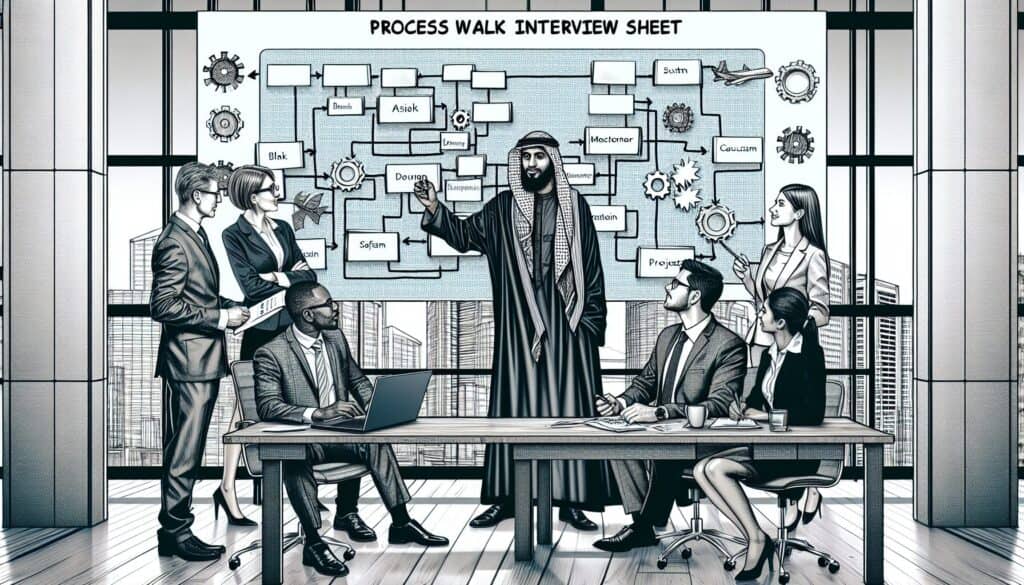Raccogliere sistematicamente informazioni e osservazioni su un processo direttamente dalle persone coinvolte, percorrendo le fasi del processo.
- Metodologie: Ergonomia
Scheda del processo di intervista a piedi

Scheda del processo di intervista a piedi
- Miglioramento continuo, Gemba, Produzione snella, Miglioramento dei processi, Mappatura dei processi, Ottimizzazione del processo, Controllo di qualità, Gestione della qualità, Mappatura del flusso di valore
Obiettivo:
Come si usa:
- Un modulo strutturato o una lista di controllo utilizzata durante un Gemba walk (andare dove si svolge il lavoro) per guidare le domande, registrare le risposte, le osservazioni e identificare potenziali problemi o opportunità di miglioramento relativi a fasi del processo, input, output e controlli.
Professionisti
- Fornisce una comprensione di prima mano del processo attuale; facilita il coinvolgimento dei dipendenti in prima linea; aiuta a identificare inefficienze e problemi nascosti; raccoglie dati qualitativi che integrano l'analisi quantitativa.
Contro
- Può richiedere molto tempo; le informazioni raccolte possono essere soggettive o aneddotiche se non ben strutturate; richiede buone capacità di intervista e di osservazione; potenziale di pregiudizio dell'osservatore.
Categorie:
- Risorse umane, Lean Sigma, Produzione, Risoluzione dei problemi, Qualità
Ideale per:
- Ottenere una visione approfondita dello stato attuale di un processo e identificare le opportunità di miglioramento attraverso l'osservazione diretta e l'interazione con chi svolge il lavoro.
The Process Walk Interview Sheet methodology is particularly effective in industries such as manufacturing, healthcare, and software development, where complex workflows necessitate a thorough understanding of day-to-day operations. This approach is typically employed during improvement initiatives or quality management projects, allowing teams to capture real-time information directly from the work environment. It is often initiated by process improvement teams, quality assurance personnel, or project managers, who engage with frontline employees—those who are intimately familiar with the processes—thereby fostering collaboration and transparency. In the healthcare sector, for example, this methodology can uncover inefficiencies in patient flow or medication administration by allowing observers to see the process in action and grasp the challenges faced by healthcare staff. Similarly, in manufacturing, it can reveal bottlenecks in production lines, leading to enhanced operational efficiency. The sheet not only prompts systematic inquiry into inputs and outputs but also encourages participants to voice concerns and suggestions, which enrich the qualitative data gathered. This data complements traditional metrics, such as cycle times and defect rates, and can be instrumental during phases such as Lean Six Sigma projects aimed at reducing waste and improving customer satisfaction. Participants of the Process Walk Interview Sheet are encouraged to formulate inquiry questions that touch on various aspects, such as safety regulations or compliance with procedures, ensuring a comprehensive evaluation of each process step.
Fasi chiave di questa metodologia
- Visit the work location and observe the process in real-time.
- Engage with employees to understand their tasks and challenges.
- Ask open-ended questions to clarify specific process steps.
- Document observations and interactions directly on the interview sheet.
- Identify variations from standard procedures during the walkthrough.
- Look for signs of waste or delays in the workflow.
- Discuss inputs and outputs of each step with the team members.
- Inquire about existing controls and metrics used to assess performance.
- Record any additional comments or insights from employees.
- Conclude the walk with a discussion on potential areas for improvement.
Suggerimenti per i professionisti
- Incorporate visual aids such as process flow diagrams during the interview to facilitate clear discussions and immediate identification of bottlenecks.
- Utilize the "5 Perché" technique to delve deeper into specific issues identified; this reveals root causes that may not be evident at first glance.
- Regularly update your Process Walk Interview Sheet based on prior experiences; include lessons learned and adapt questions to focus on newly identified challenges.
Leggere e confrontare diverse metodologie, raccomandiamo il
> Ampio archivio di metodologie <
insieme ad altre 400 metodologie.
I vostri commenti su questa metodologia o ulteriori informazioni sono benvenuti su sezione commenti qui sotto ↓ , così come tutte le idee o i link relativi all'ingegneria.
Contesto storico
1949
1950
1950
1960
1960
1960
1960
1940
1950
1950
1958
1960
1960
1960
1960
(se la data non è nota o non è rilevante, ad esempio "meccanica dei fluidi", viene fornita una stima approssimativa della sua notevole comparsa)















Post correlati
Programma di produzione principale (MPS)
Personalizzazione di massa
Imbuto di marketing
Audit di marketing
Indice MAPO (Movimento e assistenza dei pazienti in ospedale)
Pianificazione delle risorse di produzione (MRP II)